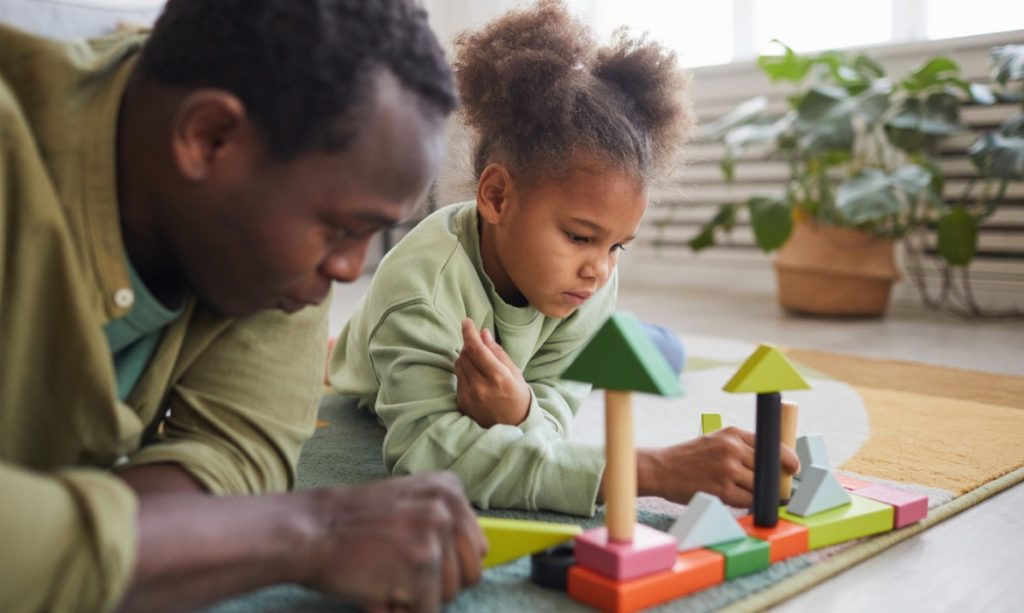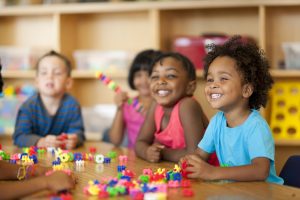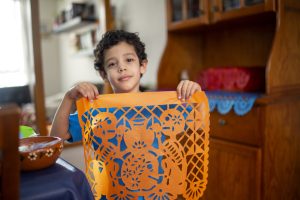- All kinds of play present opportunities to develop children’s early math skills.
- A great way to promote early math learning is to expand on children’s own comments and observations, letting children lead the play.
- We share ideas for deepening mathematical thinking during block and pretend play.
Playtime offers many opportunities for exploring early math. How can parents and caregivers take advantage of these opportunities to help children expand their mathematical thinking?
Explore Math While Playing, No Matter the Toy
In our research, we watched families play and talk together. We found that different types of toys encouraged children and caregivers to comment on different aspects of math. [1] The families were offered DUPLO blocks or a pretend kitchen set, and were asked to play with each set for about 5 minutes. These toys seemed to influence what math features parents and children noticed and talked about.
Although parents and children spontaneously commented on many math features when playing together (e.g., it’s tall, there are four cups), parents rarely expanded on the math comments that they or their children made. Expanding otherwise brief math comments is an important way to develop children’s math vocabulary, introduce children to new math concepts, and build children’s confidence in math. This can also help children practice and build math skills on their own.
One way to expand on these comments is to ask questions and keep a math conversation going, to help children build their math vocabulary and think more deeply about their math ideas. Even though we observed families playing with blocks and a kitchen set, all play offers chances to talk about math. For example, board games, dollhouses, outdoor play, and even a few empty cardboard boxes all provide opportunities to explore math ideas like space, size, measurement, order, and counting.
Here, we provide examples of ways to expand children’s mathematical thinking with questions and conversations during block play and pretend play.
Knowing the Building Goal Can Help Sharpen Skills
Block play often involves a goal, such as building a tower, making an enclosure for another toy like a car or animal, or just making something as tall or long as possible. When parents are aware of their child’s goal, they can use the information to ask questions that encourage children’s mathematical thinking, while letting the child’s interest lead the play.
Here are some questions to get children thinking about different aspects of math when building a structure. These ideas create opportunities for children to problem solve and explore key early math concepts, including shape, size, number, location, and position.
- Size: How many blocks do we need to make the tower as tall as you? Will there be enough room in the garage you are building for all your cars to fit?
- Shape: What is the shape of the house you are building? How many sides will it have? These two triangle blocks you put together are the same size as this square block. How come?
- Orientation: I see you are trying to fit the blocks together. How do we turn the blocks so they will fit together? How can we connect pieces together to make it so your bridge doesn’t fall?
- Location: On what side will you build the door to your house?
Describe and Make Suggestions
Another way parents can build on their child’s math comments is to notice and describe what their child is doing: “I see you are putting all the blocks next to each other, and you are lining up the corners and sides carefully, so they fit together.” This helps children explore math ideas and gives insight into their mathematical thinking.
Other times, building on what you observe means noticing and making suggestions, but letting your child figure out the solution: “I see you are looking for another long block to put beside this one. I don’t see another long block, but maybe these short blocks will work. How many will you need?”
Highlight More Math in Pretend Play
We found that when playing with a toy kitchen set, parents and children often talked about sharing and how many or how much of something they had. Here are some questions parents can ask during pretend play.
- Counting and Quantity: I see you are making sandwiches! How many slices of bread do we each get? Thanks for sharing the dishes! Do we have the same number of cups and plates? How can we figure it out?
- Arithmetic: How can we share the brownies, so we all get the same amount? If each of us get two cookies, how many cookies do we need to make for the three of us?
- Size: How many tomatoes will fit in the cup? How can we sort the plates and cups so we can fit them in the picnic basket?
Observe and Expand Mathematical Thinking
Just like with block play, parents can help children explore math ideas by building on children’s comments and noticing what children are doing.
Support your child’s mathematical thinking by using math vocabulary to describe what you observe: “I see you are putting one cup by each plate so that you have the same number of each. And I see you are putting one napkin to the left of each plate!”
Extend the conversation with another idea and let your child figure out the solution: “I see you are putting one cup by each plate so that you have the same number of each. How many forks will you need so that each person has a fork?”
Talk out loud and model how to solve a math problem: “To put these three plates in order from smallest to biggest, we can put them on top of each other to compare their size. See, this plate goes in the middle because it’s bigger than the smallest one but smaller than the biggest one.”
What math learning opportunities will you find in the play your child likes best?
[1] Chan, J. Y. C., Praus-Singh, T. L., & Mazzocco, M. M. M. (2020). Parents’ and young children’s attention to mathematical features varies across play materials. Early Childhood Research Quarterly, 50(3), 65–77. https://doi.org/10.1016/j.ecresq.2019.03.002



